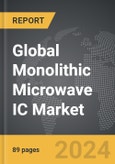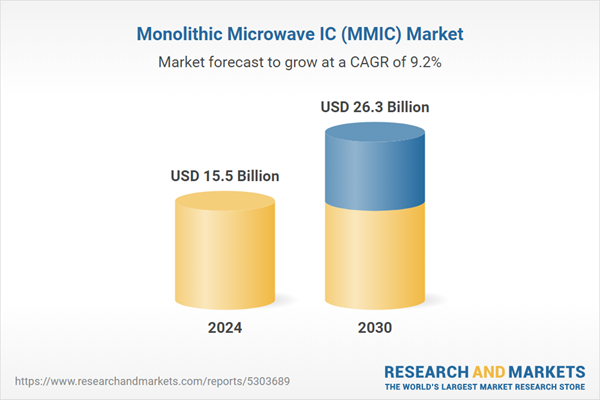The global market for Monolithic Microwave IC (MMIC) was valued at US$15.5 Billion in 2024 and is projected to reach US$26.3 Billion by 2030, growing at a CAGR of 9.2% from 2024 to 2030. This comprehensive report provides an in-depth analysis of market trends, drivers, and forecasts, helping you make informed business decisions. The report includes the most recent global tariff developments and how they impact the Monolithic Microwave IC (MMIC) market.
Segments: Component (Power Amplifiers, Low Noise Amplifiers, Attenuators, Switches, Phase Shifters, Other Components); Material Type (Gallium Arsenide, Indium Phosphide, Indium Gallium Phosphide, Gallium Nitride, Other Material Types); Application (Consumer / Enterprise Electronics, Wireless Communication Infrastructure, Automotive, Aerospace & Defense, Other Applications).
Geographic Regions/Countries: World; United States; Canada; Japan; China; Europe (France; Germany; Italy; United Kingdom; and Rest of Europe); Asia-Pacific; Rest of World.
The analysts continuously track trade developments worldwide, drawing insights from leading global economists and over 200 industry and policy institutions, including think tanks, trade organizations, and national economic advisory bodies. This intelligence is integrated into forecasting models to provide timely, data-driven analysis of emerging risks and opportunities.
Global Monolithic Microwave IC (MMIC) Market - Key Trends and Drivers Summarized
How Is Monolithic Microwave IC (MMIC) Revolutionizing Communication Technologies?
Monolithic Microwave Integrated Circuits (MMIC) are semiconductor devices used in high-frequency applications, including radar systems, satellite communications, wireless networks, and aerospace. These integrated circuits are designed to perform functions such as amplification, mixing, and signal processing at microwave frequencies, making them crucial components in modern communication systems. The increasing demand for high-speed, reliable communication networks, particularly with the rollout of 5G technology, is driving the adoption of MMICs across various industries. MMICs are widely used in applications that require compact, high-performance microwave components, including military and defense systems, automotive radar, and telecommunications infrastructure. The advantages of MMICs, such as their small size, high reliability, and ability to operate at high frequencies, make them well-suited for these applications. As the demand for high-frequency communication solutions grows, the MMIC market is expected to expand, with new developments in semiconductor materials and design techniques enhancing the performance of these circuits.What Trends Are Shaping the MMIC Market?
Several trends are shaping the MMIC market, including the rapid expansion of 5G networks, increasing adoption of advanced driver-assistance systems (ADAS), and the growing demand for satellite-based communication services. The deployment of 5G technology requires high-frequency components to support faster data transfer and increased network capacity, leading to higher demand for MMICs in telecommunications. Additionally, the automotive industry is incorporating more radar-based safety features, such as adaptive cruise control and collision avoidance, which rely on MMICs for signal processing. The defense sector continues to be a significant user of MMIC technology, with applications in radar, electronic warfare, and communication systems. As defense budgets increase and militaries modernize their equipment, the demand for high-frequency components, including MMICs, is expected to grow. Technological advancements, such as the development of Gallium Nitride (GaN)-based MMICs, are also driving the market, offering improved power efficiency and performance at higher frequencies.How Do Market Segments Shape the MMIC Industry?
Material types include Gallium Arsenide (GaAs), Silicon Germanium (SiGe), and Gallium Nitride (GaN), with GaN gaining popularity due to its superior performance at high power and frequency levels. Applications for MMICs span telecommunications, automotive, aerospace, defense, and consumer electronics, with telecommunications representing the largest market segment due to the rollout of 5G networks. Frequency ranges for MMICs include low (up to 6 GHz), medium (6-30 GHz), and high (above 30 GHz), with medium and high-frequency ranges seeing significant growth as they cater to advanced communication systems and radar applications. Geographically, North America and Asia-Pacific are the leading markets for MMICs, driven by the presence of major semiconductor manufacturers, advancements in communication technologies, and high defense spending.What Factors Are Driving the Growth in the MMIC Market?
The growth in the MMIC market is driven by several factors, including the expansion of 5G networks, increasing use of radar-based safety systems in automotive, and rising demand for satellite communications. The need for high-frequency components in modern communication systems is boosting the adoption of MMICs. Technological advancements, such as the development of GaN-based MMICs, are enhancing the performance of these circuits, making them more suitable for high-power applications. Additionally, growing defense spending and modernization of military communication systems are further contributing to market growth.Report Scope
The report analyzes the Monolithic Microwave IC (MMIC) market, presented in terms of units. The analysis covers the key segments and geographic regions outlined below.Segments: Component (Power Amplifiers, Low Noise Amplifiers, Attenuators, Switches, Phase Shifters, Other Components); Material Type (Gallium Arsenide, Indium Phosphide, Indium Gallium Phosphide, Gallium Nitride, Other Material Types); Application (Consumer / Enterprise Electronics, Wireless Communication Infrastructure, Automotive, Aerospace & Defense, Other Applications).
Geographic Regions/Countries: World; United States; Canada; Japan; China; Europe (France; Germany; Italy; United Kingdom; and Rest of Europe); Asia-Pacific; Rest of World.
Key Insights:
- Market Growth: Understand the significant growth trajectory of the Power Amplifiers segment, which is expected to reach US$9.4 Billion by 2030 with a CAGR of a 9.8%. The Low Noise Amplifiers segment is also set to grow at 8.3% CAGR over the analysis period.
- Regional Analysis: Gain insights into the U.S. market, valued at $4.4 Billion in 2024, and China, forecasted to grow at an impressive 8.5% CAGR to reach $4.0 Billion by 2030. Discover growth trends in other key regions, including Japan, Canada, Germany, and the Asia-Pacific.
Why You Should Buy This Report:
- Detailed Market Analysis: Access a thorough analysis of the Global Monolithic Microwave IC (MMIC) Market, covering all major geographic regions and market segments.
- Competitive Insights: Get an overview of the competitive landscape, including the market presence of major players across different geographies.
- Future Trends and Drivers: Understand the key trends and drivers shaping the future of the Global Monolithic Microwave IC (MMIC) Market.
- Actionable Insights: Benefit from actionable insights that can help you identify new revenue opportunities and make strategic business decisions.
Key Questions Answered:
- How is the Global Monolithic Microwave IC (MMIC) Market expected to evolve by 2030?
- What are the main drivers and restraints affecting the market?
- Which market segments will grow the most over the forecast period?
- How will market shares for different regions and segments change by 2030?
- Who are the leading players in the market, and what are their prospects?
Report Features:
- Comprehensive Market Data: Independent analysis of annual sales and market forecasts in US$ Million from 2024 to 2030.
- In-Depth Regional Analysis: Detailed insights into key markets, including the U.S., China, Japan, Canada, Europe, Asia-Pacific, Latin America, Middle East, and Africa.
- Company Profiles: Coverage of players such as Analog Devices, Inc., Arralis, Aspen Electronics Ltd., BAE Systems, BeRex and more.
- Complimentary Updates: Receive free report updates for one year to keep you informed of the latest market developments.
Some of the 33 companies featured in this Monolithic Microwave IC (MMIC) market report include:
- Analog Devices, Inc.
- Arralis
- Aspen Electronics Ltd.
- BAE Systems
- BeRex
- Broadcom
- Custom MMIC
- Infineon Technologies AG
- KYOCERA Corporation
- MACOM
- Maxim Integrated
- MICROREL Electronic Components
- Mini-Circuits
- NXP Semiconductors
- Ommic S.A.
- Qorvo, Inc
- Radiant Group of Companies
- Skyworks Solutions, Inc.
- The SETI League, Inc.
- United Monolithic Semiconductors
- Vectrawave
- WIN Semiconductors
Tariff Impact Analysis: Key Insights for 2025
Global tariff negotiations across 180+ countries are reshaping supply chains, costs, and competitiveness. This report reflects the latest developments as of April 2025 and incorporates forward-looking insights into the market outlook.The analysts continuously track trade developments worldwide, drawing insights from leading global economists and over 200 industry and policy institutions, including think tanks, trade organizations, and national economic advisory bodies. This intelligence is integrated into forecasting models to provide timely, data-driven analysis of emerging risks and opportunities.
What’s Included in This Edition:
- Tariff-adjusted market forecasts by region and segment
- Analysis of cost and supply chain implications by sourcing and trade exposure
- Strategic insights into geographic shifts
Buyers receive a free July 2025 update with:
- Finalized tariff impacts and new trade agreement effects
- Updated projections reflecting global sourcing and cost shifts
- Expanded country-specific coverage across the industry
Table of Contents
I. METHODOLOGYII. EXECUTIVE SUMMARY2. FOCUS ON SELECT PLAYERSIII. MARKET ANALYSISCANADAITALYREST OF EUROPEREST OF WORLDIV. COMPETITION
1. MARKET OVERVIEW
3. MARKET TRENDS & DRIVERS
4. GLOBAL MARKET PERSPECTIVE
UNITED STATES
JAPAN
CHINA
EUROPE
FRANCE
GERMANY
UNITED KINGDOM
ASIA-PACIFIC
Companies Mentioned (Partial List)
A selection of companies mentioned in this report includes, but is not limited to:
- Analog Devices, Inc.
- Arralis
- Aspen Electronics Ltd.
- BAE Systems
- BeRex
- Broadcom
- Custom MMIC
- Infineon Technologies AG
- KYOCERA Corporation
- MACOM
- Maxim Integrated
- MICROREL Electronic Components
- Mini-Circuits
- NXP Semiconductors
- Ommic S.A.
- Qorvo, Inc
- Radiant Group of Companies
- Skyworks Solutions, Inc.
- The SETI League, Inc.
- United Monolithic Semiconductors
- Vectrawave
- WIN Semiconductors
Table Information
| Report Attribute | Details |
|---|---|
| No. of Pages | 89 |
| Published | April 2025 |
| Forecast Period | 2024 - 2030 |
| Estimated Market Value ( USD | $ 15.5 Billion |
| Forecasted Market Value ( USD | $ 26.3 Billion |
| Compound Annual Growth Rate | 9.2% |
| Regions Covered | Global |









